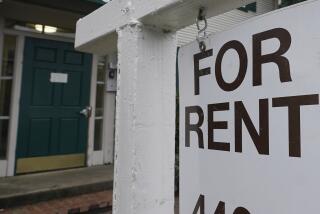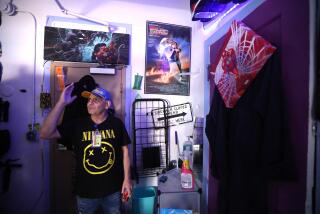Pioneering Tenant-Ownership Effort Loses Steam : Housing: Residents were to be part of a federal plan to preserve low-income units. Advocates say the government didn’t help enough.
More than a year after federal officials announced a plan to turn a low-income housing project in the San Fernando Valley into a model of private homeownership, the effort appears to have quietly failed, residents of the project say.
The government insists it is still alive. But tenant representatives say that after a flurry of introductory meetings, nothing has happened for months.
“About November everything really just died,” said Marco Figueroa, a Guatemalan immigrant and father of four who was a leader of a tenant committee organized around the proposal. “The committee stopped meeting.”
The failure of the proposal would represent a setback to the U.S. Department of Housing and Urban Development’s strategy for preserving thousands of low-income housing units.
Those involved also say the experience shows that HUD did not have a strong enough commitment to organizing the tenants.
The tenants of Sunland Park Apartments, which sit on a hill in the northeast Valley, learned in July, 1990, that they had been chosen to be pioneers. Most of the more than 300 tenants are black or Latino and have family incomes of less than $20,000 a year. Many receive welfare or housing subsidies.
The company that owns their 120-apartment complex offered them the chance to buy it, either as partners or by buying units individually. HUD officials had picked Sunland Park as a model for Los Angeles County, along with half a dozen other pilot projects in California, Arizona, Nevada and Hawaii.
Transforming low-income renters into owners is the centerpiece of HUD Secretary Jack Kemp’s free-market approach to fighting urban poverty. In various parts of the country, the government has started coverting publicly owned housing projects to private apartment complexes.
Washington’s Kenilworth-Parkside complex so far is the only government housing project in the nation that has been bought by residents. That purchase involved some controversy and has been alternately hailed as a success and criticized as chaotic.
A handful of other tenant-ownership drives are under way around the nation, according to HUD officials. In addition, management training programs for residents of public housing in Los Angeles and other cities are seen as a first step toward eventual ownership.
Sunland Park was to help open a new phase, extending the concept to privately owned housing built with government help.
The tenants formed a committee. They were visited by city officials, legal aid lawyers, professors and various other experts.
HUD officials insist that the dream of tenant ownership endures.
“From HUD’s perspective, that excitement is still there,” spokesman Scott Reed said.
But tenants, housing advocates and the owners of the complex say the idea petered out quickly.
Different players give different reasons for the problems. Most point to tenant disorganization and lack of leadership from HUD.
Obstacles to tenant ownership are particularly daunting in privately owned housing, experts say, because there is a profit-seeking owner to be dealt with, not just tenants.
“There isn’t enough hands-on technical assistance to educate residents and help them make their own choices about what is the best way to empower themselves,” said James Grow, an attorney with the National Housing Law Project in San Francisco.
The issue is urgent because the nation faces the potential loss of thousands of privately owned units from the affordable housing supply.
Many developers who received long-term, low-interest federal loans in the 1960s and 1970s have the option of paying off their mortgages at the 20-year mark and getting out of the low-income housing business. There are 645,000 units of such HUD-insured housing eligible for prepayment nationally, 40,000 of them in California, said Dirk Murphy, a spokesman in HUD’s regional office in San Francisco.
To keep them in the low-income pool, Congress passed the National Affordable Housing Act last year. It seeks to promote tenant ownership by requiring owners to try to sell to tenants or nonprofit groups.
One barrier has been a lack of money to help finance tenant buyouts. This year’s federal budget could change that. The amount tentatively approved for such tenant ownership projects is between $350 million and $440 million, officials said.
But experts say money will not solve all the problems.
“The strength of the tenant organization is essential,” Murphy said.
Some advocates question the selection of Sunland Park Apartments as a model because no organized tenant group existed there.
“This sort of took us by surprise,” said Larry Gross of the Coalition for Economic Survival, a Los Angeles tenant advocacy group. “There are tenant organizations out there that would have responded, that are much further along in terms of organization. If you just throw something like this on tenants, of course they are going to shy away.”
There were factors making the apartment complex attractive, however.
It is built around a series of spacious courtyards in a semi-rural part of Los Angeles. It is generally peaceful, if not crime-free. Its residents live in large two- and three-bedroom apartments that are in good condition.
Most importantly, according to those familiar with the project, the owners were interested.
“We feel there would be nothing to lose in at least seeing what would happen,” said Robert Hirsch, a partner in Goldrich and Kest Industries, which owns the complex. “We would be getting a fair-market price.”
Hirsch and others said the price discussed was about $9 million. The goal was a deal in which the city and federal governments would provide financial and technical assistance for the tenant buyout.
On July 17, 1990, tenants received a letter from management inviting them to “discuss the potential of resident ownership” at a meeting at an American Legion Post. About 40 tenants showed up, along with a Spanish-language translator and representatives of HUD, a legal aid clinic and the Coalition for Economic Survival.
Some tenants were less than enthusiastic, even alarmed, Gross said.
“They walked in there cold and their first reaction was: ‘We’re going to own this? What are you talking about? Who’s going to fix the roof?’ ”
“I was surprised by the reaction,” Hirsch said. “I don’t think the tenants understood.”
Nonetheless, a group of longtime residents formed a committee to pursue the idea. They met several times in August and September, with other tenants also attending, Gross said.
Experts were brought in by Coalition for Economic Survival and legal aid lawyers to tell tenants about their options. They could buy in partnership with a nonprofit group. They could buy as a cooperative. They could turn Sunland Park into a condominium complex, seeking government subsidies to help make the monthly payments.
“Some of us were really interested,” said 11-year resident Figueroa, a city employee who pays $640 a month for a three-bedroom apartment.
“What most attracted me was the chance to buy where I live,” Figueroa said. “A house would cost me $1,000 a month and a $25,000 down payment at least. There was no way I could afford that.”
Mirella Cabrera, a waitress and seven-year resident, said she was attracted by the idea of pride of ownership.
“Once you own something, you learn to take care of it,” she said. “It’s like you take care of your car or your clothes. Right now if your kid breaks something, the manager comes and fixes it. This way people wouldn’t break things because they know they would have to fix it.”
But the committee encountered confusion and apathy, especially among the poorest tenants.
“A lot of the people didn’t believe they would be able to do it,” Figueroa said. “They felt their incomes were too low. They were living on government assistance.”
Gradually, the tenants and management say, the committee disintegrated for lack of interest.
But some advocates say HUD and the owners did little more than propose the idea, then leave it to nonprofit groups with limited resources to guide the tenants through a maze.
“It’s like setting the tenants up for failure,” Gross said. “Given our resources, at a certain point we had to move on to help people at other buildings.”
The leaders among the residents, meanwhile, appear mystified by the way the opportunity came and went. Clearly, they said, some tenants were opposed. But they said others appeared interested and might have become involved if there had been more training and organization.
“Basically, we were asked if we wanted to buy the building, and that was it,” Figueroa said. “We did not get enough information about what to do or how we could do it.”
More to Read
Sign up for Essential California
The most important California stories and recommendations in your inbox every morning.
You may occasionally receive promotional content from the Los Angeles Times.










